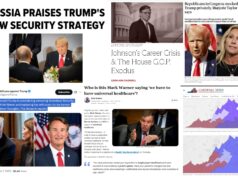Student debt is currently about $1.2 trillion. Even more staggering is that, according to Brookings Institution figures, the amount increased by 20% in just the past 2 years. And though Brookings’ research plays down the consequences, the analysis is flawed. Warner has recognized what could become a significant crisis.
There were stories about student debt on the Wall Street Journal This Morning today and in the Journal’s newspaper yesterday mentioning initiatives by Senator Elizabeth Warren (D-MA) and others. Unfortunately and maybe intentionally, our Senator’s initiatives went unheralded.
During a swing through Virginia last month, Senator Warner stopped at a number of campuses to discuss his concerns. The commercial media has not given Warner’s ideas the attention they deserve and his opponent hasn’t been challenged on the issues.
Studies like the one done at Brookings that downplay the impact of student loan debt rely on data from 2010 and before; not recent enough to capture the changes to the economic landscape precipitating from the financial crisis. They also fail to account for the debt generated from loans that paid for “educations” from predatory for-profit colleges and universities and the waste of veterans benefits squandered at those same institutions.
Plus there is an intangible factor bearing on the psyche of graduates that the Senator lays out after explaining that his own first two ventures in entrepreneurship and capitalism ended in failure and financial loss:
“The point of the story is: if I had come out with, the way many students are now, with forty, fifty, sixty, seventy thousand dollars’ worth of debt, I’m not sure I would have had the courage or ability to try to take those multiple chances.”
College debt may be an obstacle to the kind of freedom necessary for the creativity and invention that made America the leader in innovation. Warner offers a number of ideas to mitigate the challenge that student loan debt presents.
The first two involve thinking about how prospective students can look at their college options. This is particularly valuable to students who are potential first generation prospects. As part of the analysis, Warner questions whether college still has to take four years. Maybe a semester or even a year of college credit could be accomplished while still in high school. Where appropriate, he suggests students should take advantage of Advance Placement and Dual Enrollment programs. However, in some cases, paying for those credits could be a barrier to a more strategic frugality.
Proposal 1: Allow students qualifying for Pell grants to draw against them while in high school.
Ensuring that those credits really count against a degree requirement is a part of the challenge. That requires some sort of standard for matriculation agreements and transparency regarding them.
Proposal 2: “Know before you go.” Create a resource that allows prospective students full transparency on institutional outcomes:
- chances of graduating,
- average debt students take on,
- how long it normally takes to graduate,
- chances of getting a job in a matriculated field of study, and
- how much that job is going to pay
Warner points out that information like this is already collected. Making it available in a way that helps be informed consumers is the objective. He also raises a question about whether college and university programs are the best path balanced against personal aspirations. He pointed out the success of students who complete med-tech programs at Piedmont Community College which have a 95% placement rate as a suitable alternative to a bachelor’s degree.
The next three proposals are aimed at students during and after matriculation.
Proposal 3: Consolidation of debt to take advantage of lower interest rates.
This is a particular problem when there is a combination of undergraduate and graduate study debt. This actually would require major reform.
Proposal 4: Make income based repayment a broader option.
The bill that Warner and Senator Marco Rubio (R-FL) are co-sponsoring would cap the repaymment requirement at 10% of annual income. Senator Warner suggests that this helps to remove that obstacle to risk-taking he worried about earlier. It also means that more student loan debtors will have the wherewithal to afford to purchase a home, an economic sector that stands to suffer significantly if the explosion of student loan debt continues.
Proposal 5: Allow up to $5,000 of salary and wages to be paid as pre-tax when applied against student loan debt.
This would appear to be the easiest to enact, but, as Warner likes to point out, nothing is easy in Washington. It is not dissimilar to the pre-tax designation doesn’t cost the employer anything and the employee is rewarded for paying off the debt.
“In a global economy…in an economy where talent and access to capital are going to be driving forces, you shouldn’t go broke in America going to college.Unfortunately…we are pricing the ability to get an education and skills you need beyond your reach.”
The Senator points out that one of the reasons education is pricing prospects out of the market is that over the last 20 years the support for education at the state and federal levels has been almost a straight slope downward. Meanwhile if you look at the cost of education it is almost a straight line up.
“If students, if young people voted in their percentages, this would be a top five issue in the country.”
It should be at the top of the list for every person with an outstanding student loan. And at the top of the list for housing developers and, for that matter, anyone who relies on disposable income to fuel sales. What studies like the one produced for Brookings fail to account for are the lowered income expectations and diminished employment opportunities resulting from the financial crisis.
It is also a shame that something along the lines of “Know before you go” wasn’t available to thousands of veterans who benefitted from Senator Jim Webb’s GI Bill but were unprepared to be discerning consumers. The market responded with a proliferation of “educational programs” offered by for-profit institutions. Too many of those “opportunities” overpromised and under-delivered. While left with less debt than their non-veteran contemporaries, they often ended up without degrees or with worthless credentials. And for that learning experience, they too often borrowed money for the more expensive tuition and expenses that exceeded their benefits. Though these proposals can do nothing to undo the harm already done, they will better arm those who follow and who, by the way, would be disproportionately first generation college students.
“Know before you go” could provide the kind of scrutiny that for-profit educators fear. Not only would consumers be better armed, but given the availability of that kind of data lending institutions and maybe even student loan authorities might begin to scrutinize the potential earning power of borrowers in assessing lending risk when approving loans. Right now that risk is casually ignored because debt from government student loans cannot be forgiven in bankruptcy. Maybe changing that lender protection is something that should be added to the Senator’s proposals.
But there are also proposals that would actually exacerbate the problems. One by Senator Paul Ryan would have interest begin accruing while students are still in school. Additionally his budget proposal would roll back expansions of Pell grants; quite the antithesis of the direction Mark Warner would take us.
So while these issues have not gained much traction during this election season, maybe the fact that there is some focus this close to election-day they will influence some to get out and vote. The explosion of student loan debt over the last few years is substantially a millennial burden. We already know that millennials favor Senator Warner. This may be an issue that actually gets them to the polls.















![[UPDATE: Mike Jones Wins 71%-29%] VA Senate President Pro Tem Louise Lucas Calls 1/6/26 Special Election to Fill Seat of VA Sen./LG-Elect Ghazala Hashmi; Nominees to Be Chosen This Weekend](https://bluevirginia.us/wp-content/uploads/2025/12/508fdf46a3c3abca1cbad1ef17efd1d79703f8713f842da38c548c8c13686d0c-100x75.jpg)